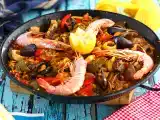Flavor and tradition: The key ingredients that define authentic Spanish gastronomy.

Spanish cuisine is internationally recognized thanks to its diversity and richness of flavors. Centuries of history, tradition and culture are reflected in its gastronomy. Each autonomous community has its own specialties, but there are certain fundamental ingredients that are common to many recipes and that form the basis of Spanish cuisine. In this article we are going to enumerate the list of essential ingredients that you must have if you want to make typical Spanish recipes at home.
1. Olive oil: Spain's liquid gold
Extra virgin olive oil is, without a doubt, the mainstay of Spanish cuisine. Spain is the world's largest producer of olive oil, and it is used in the preparation of most of its dishes, from salads to stews and essential for its fried foods. This "liquid gold", rich in antioxidants and healthy fats, provides a unique flavor and defines the character of many traditional recipes such as gazpacho, salads, and the classic bread with tomato.
2. Iberian ham: a gastronomic jewel
Iberian ham, especially acorn-fed Iberian ham, is another of Spain's star products. It comes from the Iberian pig, raised in the wild and fed on acorns, and its flavor is unmistakable. It can be eaten alone or as part of pintxos, tapas, sandwiches and traditional recipes such as huevos rotos. It is also used to prepare stews and casseroles.
3. Paprika: the essence of color and flavor.
Paprika is an indispensable spice in Spanish cuisine, especially the one known for bringing a vibrant color and flavor (smoky or sweet) to numerous dishes. It is used in iconic preparations such as Galician-style octopus, chistorra sausage or lentil stews. There are different varieties, being paprika de la Vera, one of the most valued for its intense and smoky flavor.
4. Garlic: the king of fried foods
Garlic is a fundamental base in most sofritos and sauces in Spanish cuisine. This versatile ingredient is used in all kinds of preparations, from "Ajo blanco" (a typical cold soup from Andalusia), to accompanying meats, fish and stews. In addition to its flavor, it is valued for its medicinal properties.
5. Saffron: the touch of distinction in paella.
Saffron, although of Arabic origin, is an essential ingredient in dishes such as paella and other rice stews. This spice, one of the most expensive in the world due to its laborious harvesting, provides a golden color and a subtle flavor that cannot be replicated by other seasonings. It is fundamental in many traditional recipes in the Valencian region and other parts of the country.
6. Tomato: the base of sauces and salads.
Tomato is another ubiquitous ingredient in Spanish gastronomy. It is used fresh, in sauce, in stir-fries or even grated to spread on bread in the popular "tosta de pan con tomate" (toast with tomato). Gazpacho and salmorejo, two cold tomato-based soups, are symbols of the Spanish summer and an example of the versatile use of this product in the national cuisine.
7. Legumes: a mainstay of the Mediterranean diet
Legumes, such as lentils, chickpeas and beans, are another essential component of the Spanish diet, both for their nutritional value and their history. Traditional dishes such as cocido madrileño, fabada asturiana or lentils with chorizo are representative of the use of legumes in stews and casseroles, offering a combination of flavor and nutrients.
8. Fish and seafood: from sea to table
Spain has an extensive coastline, which has facilitated the consumption of fish and seafood in all its forms. Dishes such as zarzuela de pescado, bacalao a la vizcaína, boquerones en vinagre or grilled prawns are examples of the importance of seafood in the Spanish diet.
9. Chorizo and sausages: the taste of tradition
Chorizo, salchichón and other sausages are indispensable in Spanish cuisine. Whether as a tapa, in sandwiches or in stews, their characteristic flavor marks many iconic dishes. Chorizo is used to give body and flavor to recipes such as cocido or fabadas, and it is hard to imagine a Spanish pantry without a selection of sausages.
10. Wine: a gastronomic and cultural companion
Wine is part of Spanish culture and gastronomy. Both red wines from Rioja or Ribera del Duero, as well as white wines from Rueda or fortified wines such as Jerez, are common accompaniments to meals. In addition, wine is used in the preparation of some dishes, such as roast suckling pig.
Time to put on your apron
Now that we have our pantry well stocked with typical Spanish products, it is time to use them to enjoy some of these delicious recipes.

Huevos rotos, the super easy spanish recipe - broken eggs

Seafood paella

Tomato and serrano ham toast - the perfect spanish tapas

Spanish garlic soup - video recipe !

Traditional catalan cream

Air fryer spanish croquetas: little oil but still just as crispy!

Cocido - spanish-style stew

Natillas, the spanish egg custard

Comments